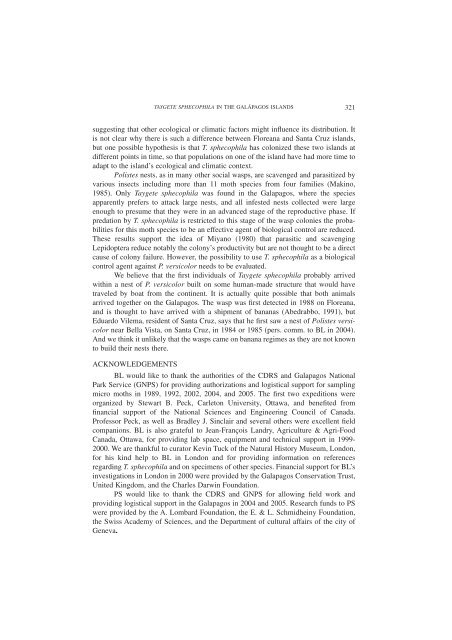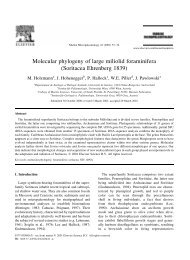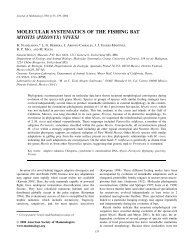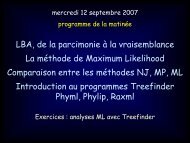Landry et al. 2006.pdf - Webspace
Landry et al. 2006.pdf - Webspace
Landry et al. 2006.pdf - Webspace
Create successful ePaper yourself
Turn your PDF publications into a flip-book with our unique Google optimized e-Paper software.
TAYGETE SPHECOPHILA IN THE GALÁPAGOS ISLANDS321suggesting that other ecologic<strong>al</strong> or climatic factors might influence its distribution. Itis not clear why there is such a difference b<strong>et</strong>ween Floreana and Santa Cruz islands,but one possible hypothesis is that T. sphecophila has colonized these two islands atdifferent points in time, so that populations on one of the island have had more time toadapt to the island’s ecologic<strong>al</strong> and climatic context.Polistes nests, as in many other soci<strong>al</strong> wasps, are scavenged and parasitized byvarious insects including more than 11 moth species from four families (Makino,1985). Only Tayg<strong>et</strong>e sphecophila was found in the G<strong>al</strong>apagos, where the speciesapparently prefers to attack large nests, and <strong>al</strong>l infested nests collected were largeenough to presume that they were in an advanced stage of the reproductive phase. Ifpredation by T. sphecophila is restricted to this stage of the wasp colonies the probabilitiesfor this moth species to be an effective agent of biologic<strong>al</strong> control are reduced.These results support the idea of Miyano (1980) that parasitic and scavengingLepidoptera reduce notably the colony’s productivity but are not thought to be a directcause of colony failure. However, the possibility to use T. sphecophila as a biologic<strong>al</strong>control agent against P. versicolor needs to be ev<strong>al</strong>uated.We believe that the first individu<strong>al</strong>s of Tayg<strong>et</strong>e sphecophila probably arrivedwithin a nest of P. versicolor built on some human-made structure that would hav<strong>et</strong>raveled by boat from the continent. It is actu<strong>al</strong>ly quite possible that both anim<strong>al</strong>sarrived tog<strong>et</strong>her on the G<strong>al</strong>apagos. The wasp was first d<strong>et</strong>ected in 1988 on Floreana,and is thought to have arrived with a shipment of bananas (Abedrabbo, 1991), butEduardo Vilema, resident of Santa Cruz, says that he first saw a nest of Polistes versicolornear Bella Vista, on Santa Cruz, in 1984 or 1985 (pers. comm. to BL in 2004).And we think it unlikely that the wasps came on banana regimes as they are not knownto build their nests there.ACKNOWLEDGEMENTSBL would like to thank the authorities of the CDRS and G<strong>al</strong>apagos Nation<strong>al</strong>Park Service (GNPS) for providing authorizations and logistic<strong>al</strong> support for samplingmicro moths in 1989, 1992, 2002, 2004, and 2005. The first two expeditions wereorganized by Stewart B. Peck, Carl<strong>et</strong>on University, Ottawa, and benefited fromfinanci<strong>al</strong> support of the Nation<strong>al</strong> Sciences and Engineering Council of Canada.Professor Peck, as well as Bradley J. Sinclair and sever<strong>al</strong> others were excellent fieldcompanions. BL is <strong>al</strong>so grateful to Jean-François <strong>Landry</strong>, Agriculture & Agri-FoodCanada, Ottawa, for providing lab space, equipment and technic<strong>al</strong> support in 1999-2000. We are thankful to curator Kevin Tuck of the Natur<strong>al</strong> History Museum, London,for his kind help to BL in London and for providing information on referencesregarding T. sphecophila and on specimens of other species. Financi<strong>al</strong> support for BL’sinvestigations in London in 2000 were provided by the G<strong>al</strong>apagos Conservation Trust,United Kingdom, and the Charles Darwin Foundation.PS would like to thank the CDRS and GNPS for <strong>al</strong>lowing field work andproviding logistic<strong>al</strong> support in the G<strong>al</strong>apagos in 2004 and 2005. Research funds to PSwere provided by the A. Lombard Foundation, the E. & L. Schmidheiny Foundation,the Swiss Academy of Sciences, and the Department of cultur<strong>al</strong> affairs of the city ofGeneva.






